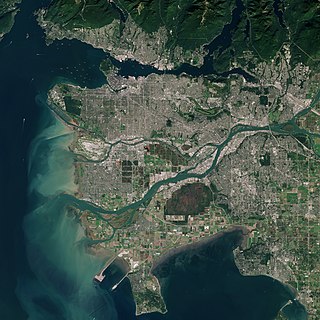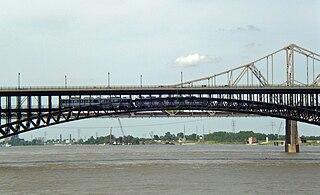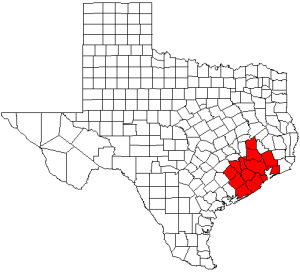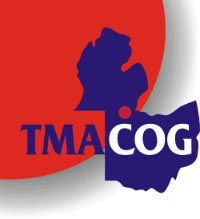The East-West Gateway Council of Governments (EWGCOG or EWG) is the official Council of Governments and Metropolitan planning organization for Greater St. Louis, USA. It was incorporated in 1965.
The council coordinates planning and problem solving in areas of governmental responsibility for transportation planning that impact more than one jurisdiction in the Greater St Louis area. The organization serves St. Louis City. Franklin County, Jefferson County, St. Charles County, and St. Louis County in Missouri, plus Madison County, Monroe County, and St. Clair County in Illinois. It included highway expansion and planning public transportation.
The council is headed by a board of directors as official governance, with associate members from throughout the region.

St. Louis County is located in the eastern-central portion of Missouri. It is bounded by the City of St. Louis and the Mississippi River to the east, the Missouri River to the north, and the Meramec River to the south. At the 2020 census, the total population was 1,004,125, making it the most populous county in Missouri. Its county seat is Clayton. The county is included in the St. Louis, MO–IL metropolitan statistical area.

The Metro Vancouver Regional District (MVRD), or simply Metro Vancouver, is a Canadian political subdivision and corporate entity representing the metropolitan area of Greater Vancouver, designated by provincial legislation as one of the 28 regional districts in British Columbia. The organization was known as the Regional District of Fraser–Burrard for nearly one year upon incorporating in 1967, and as the Greater Vancouver Regional District (GVRD) from 1968 to 2017.

The Metropolitan Council, commonly abbreviated Met Council or Metro Council, is the regional governmental agency and metropolitan planning organization in Minnesota serving the Twin Cities seven-county metropolitan area, accounting for over 55 percent of the state's population. It is one of two multi-county regional governments in the United States, the other being the Portland Metro.
A Pure Michigan Byway is the designation for a segment of the State Trunkline Highway System in the US state of Michigan that is a "scenic, recreational, or historic route that is representative of Michigan's natural and cultural heritage." The designation was created with the name Michigan Heritage Route by the state legislature on June 22, 1993, and since then six historic, seven recreational and seven scenic byways have been designated by the Michigan Department of Transportation (MDOT), and another two have been proposed. These byways have been designated in both the Upper and Lower peninsulas of the state. The current name was adopted on December 30, 2014, and it references the Pure Michigan tourism marketing campaign.

Michiana is a region in northern Indiana and southwestern Michigan centered on the city of South Bend, Indiana. The Chamber of Commerce of St. Joseph County, Indiana defines Michiana as St. Joseph County and "counties that contribute at least 500 inbound commuting workers to St. Joseph County daily." Those counties include Elkhart, La Porte, Marshall, St. Joseph, and Starke in Indiana, and Berrien and Cass in Michigan. As of the 2010 census, those seven counties had a population of 856,377.
Councils of governments are regional governing and/or coordinating bodies that exist throughout the United States. CoGs are normally controlled by their member local governments, though some states have passed laws granting CoGs region-wide powers over specific functions, and still other states mandate such councils.

Greater St. Louis is a bi-state metropolitan area that completely surrounds and includes the independent city of St. Louis, the principal city. It includes parts of both Missouri and Illinois. The city core is on the Mississippi Riverfront on the border with Illinois in the geographic center of the metro area. The Mississippi River bisects the metro area geographically between Illinois and Missouri; however, the Missouri portion is much more populous. St. Louis is the focus of the largest metro area in Missouri and the Illinois portion known as Metro East is the second largest metropolitan area in that state. St. Louis County is independent of the City of St. Louis and their two populations are generally tabulated separately.

Metro is the regional government for the Oregon portion of the Portland metropolitan area, covering portions of Clackamas, Multnomah, and Washington Counties. It is the only directly elected regional government and metropolitan planning organization in the United States. Metro is responsible for overseeing the Portland region's solid waste system, general planning of land use and transportation, maintaining certain regional parks and natural areas, and operating the Oregon Zoo, Oregon Convention Center, Portland's Centers for the Arts, and the Portland Expo Center. It also distributes money from two voter-approved tax measures: one for homeless services and one for affordable housing.

A metropolitan planning organization (MPO) is a federally mandated and federally funded transportation policy-making organization in the United States that is made up of representatives from local government and governmental transportation authorities. They were created to ensure regional cooperation in transportation planning. MPOs were introduced by the Federal-Aid Highway Act of 1962, which required the formation of an MPO for any urbanized area (UZA) with a population greater than 50,000. Federal funding for transportation projects and programs are channeled through this planning process. Congress created MPOs in order to ensure that existing and future expenditures of governmental funds for transportation projects and programs are based on a continuing, cooperative, and comprehensive ("3-C") planning process. Statewide and metropolitan transportation planning processes are governed by federal law. Transparency through public access to participation in the planning process and electronic publication of plans now is required by federal law. As of 2015, there are 408 MPOs in the United States.
The Metropolitan Transportation Commission (MTC) is the government agency responsible for regional transportation planning and financing in the San Francisco Bay Area. It was created in 1970 by the State of California, with support from the Bay Area Council, to coordinate transportation services in the Bay Area's nine counties: Alameda, Contra Costa, Marin, Napa, San Francisco, San Mateo, Santa Clara, Solano, and Sonoma. The MTC is fourth most populous metropolitan planning organization in the United States.

Metro Transit is an enterprise of Bi-State Development, an interstate compact formed by Missouri and Illinois in 1949. Its operating budget in 2016 was $280 million, which is funded by sales taxes from the City of St. Louis and St. Louis County, the St. Clair County Illinois Transit District, federal and state grants and subsidies, and through fare paying passengers. In 2021, the system had a ridership of 17,947,900, or about 62,700 per weekday as of the third quarter of 2022.
Regional Planning Councils (RPCs) are quasi-governmental organizations that are designated by Florida law (Ch. 186, Florida Statutes) to address problems and plan solutions that are of greater-than-local concern or scope, and are to be recognized by local governments as one of the means to provide input into state policy development. With regard to transportation-related issues, RPCs are empowered to provide technical assistance to local governments on growth management matters; coordinate land development and transportation policies in a manner that fosters region-wide transportation systems; review local government comprehensive plan amendments, evaluation/appraisal reports, and Developments of Regional Impacts for consistency with state and regional plans; and, review the plans of independent transportation authorities and metropolitan planning organizations to identify inconsistencies between those plans and applicable local government plans. RPCs are a type of Regional planning organization, specific to the state of Florida.

Transportation in Greater St. Louis, Missouri includes road, rail, ship, and air transportation modes connecting the bi-state St. Louis metropolitan area with surrounding communities throughout the Midwest, national transportation networks, and international locations. The Greater St. Louis region also supports a multi-modal transportation network that includes bus, paratransit, and light rail service in addition to shared-use paths, bike lanes and greenways.

The Houston-Galveston Area Council (H-GAC) is the region-wide voluntary association of local governments in the 13-county Gulf Coast Planning Region of Texas. The organization works with local government officials to solve problems across the area. H-GAC was founded in 1966.

The Toledo Metropolitan Area Council of Governments (TMACOG) is a voluntary organization of dues-paying members. TMACOG members include governmental and non-governmental organizations in northwest Ohio and southeast Michigan: cities, counties, villages, and townships, as well as schools and colleges, park districts, businesses, and other groups concerned with quality of life in the region. TMACOG is both a regional council and a metropolitan planning organization.

Maricopa Association of Governments (MAG) is a Council of Governments (COG) that serves as the regional agency for the greater Maricopa region in Arizona, United States. This includes the Phoenix area and the neighboring urbanized area in Pinal County, containing the Town of Florence and City of Maricopa. When MAG was formed in 1967, the elected officials recognized the need for long-range planning and policy development on a regional scale. They realized that many issues such as transportation, air quality and human services affected residents beyond the borders of their individual jurisdictions.

Brockton Area Transit Authority, branded as Brockton Area Transit (BAT), is a public, non-profit organization in Massachusetts, charged with providing public transportation to the Brockton area, consisting of the city of Brockton and the adjoining towns of Abington, Avon, Bridgewater, East Bridgewater, Easton, Hanson, Rockland, Stoughton, West Bridgewater and Whitman.

San Bernardino Associated Governments was an association of the San Bernardino County local governments and the regional transportation planning agency Including also regional planning organization for the county, with policy makers consisting of mayors, councilmembers, and county supervisors. It was also the funding agency for the county's transit systems, which include Omnitrans, Victor Valley Transit Authority, Morongo Basin Transit Authority, Mountain Area Regional Transit Authority, Barstow Area Transport, and Needles Area Transit.

Councils of governments in Connecticut are organizations that bring together the chief elected officials and/or professional managers from member municipalities in Connecticut. The bodies are meant to aid coordination among neighboring cities and towns, and between the towns and the state government, on issue including land use, zoning, and transportation. They serve some functions analogous to county governments in other states, but have no independent taxing authority. Councils of government also host some intermunicipal services based on the needs and voluntary participation of member or client municipalities. Councils, or COGs, receive funding through membership dues, state grants, and federal grants. As of 2015, the State of Connecticut recognized COGs as county equivalents, allowing them to apply for funding and grants made available to county governments in other states.
Regional Development Commissions are regional governments in Minnesota made up of a board of local elected officials from counties, cities, schools boards, public interest groups and transit systems that provide cooperation and coordination on broad regional issues. The Regional Development Commissions, commonly abbreviated as RDC, were established by state law in 1969 to provide a variety of governmental assistance to local governments. They are a type of regional planning organization that have responsibility to provide technical assistance to a broad multi-county area of the state, and their functions are similar to the metropolitan planning organization in urbanized areas. As their intent was to support local governments, they frequently provide a coordinating role and generally do not exercise any type of binding authority over local matters.